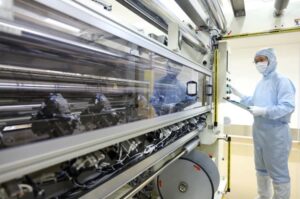Currently, electrolyzers and fuel cells are produced in relatively small quantities and at high cost, with little automation involved. Fraunhofers Reference-factory.H2 offers the potential for science and industry to catapult the production of hydrogen systems into a new era of efficient industrial mass production.
Unique
To ensure the successful outcome of this action, existing production technologies must be analyzed and evaluated in terms of their use for high-quality serial production of electrolyzers and fuel cells. New continuous processes and systems are also required to pave the way toward mass production. This is the only way to substantially reduce the production effort and to ultimately put hydrogen on an equal cost footing with fossil energy sources. Reference Factory.H2 was designed for the flexible, dynamically adaptable, quantity-scalable serial production of hydrogen systems. The concept is unique because of the direct opportunities for industrial involvement. Companies can be both users of the services and partners of Reference-factory.H2
Physical and virtual components
Reference-factory.H2 is a production system based on physical and virtual components. It is used to create a reference design and new technology solutions, while existing ones are optimized. At the same time, digital twins of the production elements are developed and incorporated in a virtual architecture. This creates a modular system of technologies that are compared with each other and flexibly combined in process chains.
Acceleration of transfer to industry
“Reference-factory.H2 allows us to use regional expertise and infrastructures better so that industry can be more closely involved in development. This accelerates the transfer of the solutions to industry,” says Dr. Ulrike Beyer, Head of the Hydrogen Task Force at Fraunhofer IWU and coordinator of the project. “We’re basically building a B2B platform in which we merge the core areas of expertise of the Fraunhofer Institutes and the partners involved to create a highly effective value chain for hydrogen systems, thus providing potential stakeholders with a holistic overview of the economic opportunities,” says Beyer. The virtual images offer the research teams the chance to simulate the networking of new production processes and systems, and to check and compare them in detail on the computer, thus selecting the appropriate materials, tools and systems for achieving effective production. As a result, overall relationships can be clearly displayed right up to complete process chains, and it is possible to evaluate the cost incurred in the production of hydrogen systems.
Market uptake from 2025
Plans exist for offering services and specific forms of involvement to German industry starting in the third quarter of this year. The common objective will be to develop production technologies and systems conducive to the serial production of fuel cells and electrolyzers, which will substantially support market uptake from 2025.
Hydrogen lighthouse project
Reference-factory.H2 was designed by the Fraunhofer Institute for Machine Tools and Forming Technology IWU in Chemnitz and is operated together with the Fraunhofer Institute for Production Technology IPT in Aachen. The research content of the Fraunhofer Institute for Electronic Nano Systems ENAS in Chemnitz and the Fraunhofer Institute for Manufacturing Engineering and Automation IPA in Stuttgart are also incorporated. The Reference-factory.H2 concept also is a key element of the FRHY – Reference Factory for High-Rate Electrolyzer Production group from the hydrogen lighthouse project involving the Fraunhofer concept ‘H2GO – National Action Plan for Fuel Cell Production,’ in which 14 other Fraunhofer Institutes are involved.
Opportunity for hydrogen system production
“The stack is at the core of the hydrogen systems and also is the place where the water is split and electricity generated,” explains Beyer. This stack consists of several hundred stacked interconnected individual cells in which the chemical energy conversion takes place. Due to its multiple repeating elements, it makes sense to shift the production of the stack to industrial production involving large quantities, thus substantially reducing cost.
BPP and MEA
The reference-factory includes machines and systems for producing the key stack components: the bipolar plate (BPP) and membrane electrode assembly (MEA). “The new concept makes it possible to locally carry out the necessary technology developments locally on site, so that a forming press can be available for BPPs in Chemnitz and a production plant for the MEA in Aachen. Their digital twins are brought together centrally in a common architecture, where they are used for process comparisons and evaluations, or for considerations regarding process chains,” explains Beyer. The aim is to develop a modular system of technologies whose individual components can be evaluated technologically and economically. This system intends to reduce the investment risk and support companies in the development of their hydrogen field of business.
Details about the Reference-factory.H2 concept, the range of services and the opportunity to become involved will be available to interested visitors at the Hannover Messe 2022 at the joint Fraunhofer booth.






